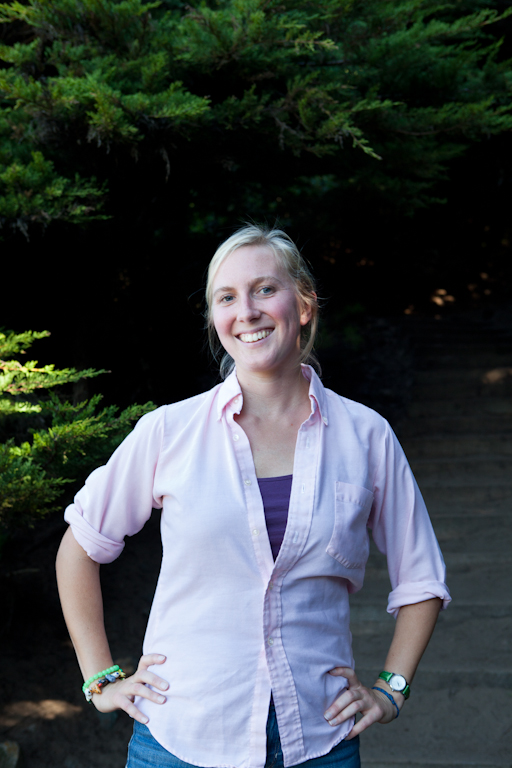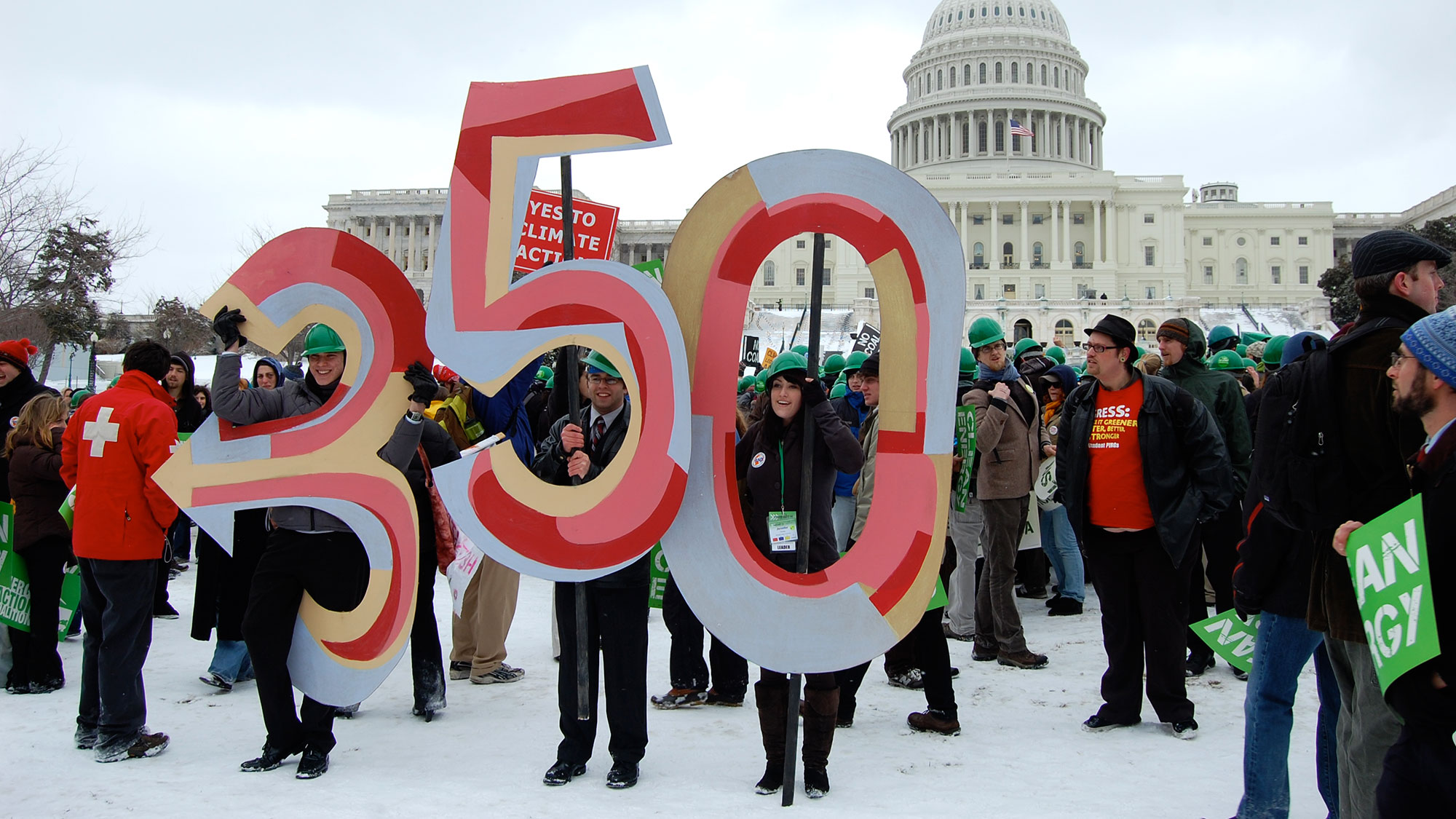May Boeve grew up in the ’90s, in a world where environmentalism was presented less as a social movement than as a personal lifestyle choice: buy a car that doesn’t use much gas, insulate your house, use energy-efficient lightbulbs, compost.
So when she was an undergraduate at Middlebury College, she and a group of friends set out to practice environmentalism differently, taking their cues from the social justice movements they were learning about in history class (civil rights) and seeing play out in the world around them (marriage equality).
“Clearly, a lot of people were concerned about climate change,” Boeve said in an interview earlier this year. “But it didn’t look like the movements we’d studied in school, with protests and songs and visual imagery and analyses of power and all these intricate things.”

photo by Ryan HeffernanMay Boeve.
Today, Boeve is the executive director of 350.org, an environmental organization that she and that same group of friends cofounded specifically to work on climate change. The group is cut from a different cloth than its more mature green-activist siblings; a recent survey of movement groups described it as “the slightly strange kid” of the green class.
Despite (or because of) its unorthodoxy, and working with a budget and staff a fraction of the size of those of major environmental organizations like the Sierra Club and the Environmental Defense Fund, 350.org has sparked two of the highest-profile environmental campaigns in recent history: the effort to stop the Keystone XL pipeline and the fossil fuel divestment movement. This Monday, 350.org, together with the Rainforest Action Network, the Sierra Club, Credo Mobile, and the Natural Resources Defense Council, organized hundreds of vigils across the country in protest of the State Department’s Environmental Impact Review of the Keystone XL pipeline.
How has the organization done it? Boeve talked with me recently about the origins of 350.org — and what they have to do with network theory, the internet, and not knowing entirely what you’re getting into.
Q. So you and a group of friends started organizing while you were in college. Did you plan to keep doing it after college, or did it just sort of happen?
A. We were a group of friends about to graduate from college who had been very active in the Campus Climate Challenge movement. We decided that we wanted to work together when we graduated. So we devised this plan where we were going to move someplace where there was a lot of coal on the verge of being mined and burned. We made a GIS map overlaying coal reserves, wind energy potential, universities — and microbreweries.
Q. Why microbreweries?
A. We thought it was a good proxy of a place that we would enjoy living.
Q. That’s a good matrix.
A. It’s a useful matrix for sure. We decided on Billings, Mont. We all agreed we were going to move there when we graduated in 2007.
At the same time, Bill McKibben, who we knew a little bit, organized this five-day walk across the state of Vermont, which had turned out to be a big event. So he asked us if we would be willing to help him organize a national version of this march, and that’s what Step It Up became. We shelved the Billings idea.
And then, after Step it Up, at the end of 2008, we really came together to form 350.org.
Q. I feel like you were one of the first environmental organizations to really get social media. How much of the organizing you do is over the internet, and how is the way that you’ve done it changed since you started?
A. When we started, we organized by sitting down with our laptops at seven chairs and one folding table. We emailed everyone that we knew, which wasn’t a lot of people. Then we emailed everyone Bill McKibben knew, which was a whole lot of people. We asked if they would be interested in participating in a national Day of Action on climate that would call on Congress to cut carbon emissions by 80 percent by 2050. The seed of what 350.org eventually became, was, if we could make all these connections from one place to the U.S., wouldn’t that also be possible around the world? So technology has been central to what we think about the possibility of our work from the beginning.
What’s interesting to me is as we’ve grown, we’ve done broad organizing, but we’ve also expanded how much deep organizing we do. Technology is important to both — whether you’re having a meeting to support an organization trying to get a divestment resolution passed in their community, or getting hundreds of thousands of comments to the State Department about Keystone. Digital technology can facilitate network-building, and is often followed up by the direct, “old-fashioned” technology of face-to-face meetings.
Q. And so by deep organizing, do you mean — if someone wants to do a campaign and they don’t have much experience, 350.org would do more work with them one-on-one, in how to organize?
A. Exactly. We organized a summit this June called Global Power Shift. Our goal was to bring together leaders we’d encountered around the world. There were workshops on campaigning, creative activism, online strategy. Every participant connected with a regional organizer who is on 350.org’s staff, and those regional organizers since that time have helped support training within their region.
Q. I was just talking to someone who was involved in the SNCC (Student Nonviolent Coordinating Committee) and that sounds a lot like how that aspect of the civil rights movement was run. Or is that more of a standard model?
A. It’s a traditional mode of organizing, but it seems like more and more organizations are trying to make a networked approach, which relies less on central control and more interconnectedness among networks. So instead of us sending out a press release to all of the networks, they share it with each other.
We’re participants in something called the Network Innovation Lab, which is trying to gather lessons learned and effective models. The boundaries between people who are on staff and people who are not on staff are much more porous in a network. We have lots of local groups who have their own funding sources and are technically independent.
Q. I was talking to Marshall Ganz a few days ago and he was talking about developing a network plan like that several years ago for an environmental organization. The staff of the organization didn’t want to give up the control. And so the plan wound up not being used by the organization it was made for, but it was used years later as the structure for the Obama campaign.
A. It’s a really live question. We’re at a place where we could go forward with a more traditional chapter model. We’ve never had that before. And because all of this interesting work that is being done around networks and because of what we’re observing in our own community — there’s lots of benefits to a more informal peer network. But it’s a very live question.
Q. In organizing, are there any models that you look up to?
A. One group that I’m really a fan of is the National Domestic Workers Alliance. They’ve got a relatively small central staff but most of their power and strength lies in their network, which is mostly state-based affiliate groups. The groups in many cases were already active and then decided to affiliate with this national agency. The NDWA organize in the U.S., but they’re also part of an international network.
I often look at their website in terms of how they describe what is the NDWA. It’s staff. It’s affiliates. It’s partner organizations. It’s a new way of thinking certainly about a nonprofit organization and about how to do things internally.
We’ve been working within 350.org with a group called 350 Australia which started very soon after we did, in 2008. There’s an incredible organizer there named Blair Palese. She really liked the way we were campaigning and thought it could work in Australia, so she registered and started fundraising and has had a staff there for many years. They’re running a divestment campaign that is incredibly successful but they’re also their own independent entity. We’re often trying to figure out the best way to provide the kind of support they need from us while recognizing that in their independence they derive a lot of value.
So as we’re growing, and we have more and more incredible local leaders, the question of the relationship to our central team is one that’s incredibly interesting. For the moment we’re just experimenting — try different things, see what works, see what can be applied more broadly across the network.
Q. When you make a big shift — like to do direct action for Keystone — was that a decision made by the central group?
A. It was something we considered very thoroughly. Most especially with groups and networks that were doing work with tar sands already, like indigenous peoples, farmers and ranchers, and the Tar Sands Coalition. Before, we’d been relatively quiet on the topic of tar sands, but we thought this Keystone pipeline would be a very powerful way to galvanize the climate movement. It required a presidential permit. It was good timing to influence the president before the election took over every news story. There was all this existing campaigning and organizing happening.
So a lot of the early work was on that sphere and then thinking: “Who knows how to do this?” And thankfully there are a lot of people in the environmental movement who are great direct action organizers, some of whom now work with us. We pulled from a network of existing direct action trainers. A lot of them were with the Ruckus Society.
Something you may know already is that Tar Sands Action — the entity that put that on — we organized as a separate project.
Q. So Tar Sands Action didn’t exist before then? Does it exist now?
A. Not really. I characterize it more as a network. There were 1,250 people who were arrested during the two-week sit-ins. There was an incredible sense of identity connected to that — there will always be, to people who participated.
But subsequently 350.org began to do a lot of Keystone campaigning ourselves. And so that’s how that evolved. Now 350.org has a big Keystone campaign, and we continue to collaborate with many other organizations and networks.
Q. Why create a separate organization?
A. The main reason they were separate was for legal reasons. We had never organized something of this nature and there were legal considerations, so that was the rationale there.
Q. What’s the difference going from leading a student organization to leading a national one?
A. All the 350.org cofounders and a lot of the people who work on our team were part of this early wave of the youth climate movement — the Energy Action Coalition and the Campus Climate Challenge campaign, which was about getting our colleges and universities to commit to strong sustainability principles.
It was incredibly exciting. I can’t underscore enough how it felt. The late-night meetings and actions and strategy sessions with my friends — it was incredibly exciting. The work is still meaningful, but for an entirely different group of reasons. Because now we’re influenced by a wider range of ideas — including what our base is interested in.
Which is, in many cases, fossil fuel infrastructure projects in their backyards, from India to Vietnam to California. And as the fossil fuel industry continues to find new resources to exploit, the battle only gets bigger. More and more people are finding themselves a part of this movement because there’s a pipeline running through their backyard. People are being sucked into this, and that influences our work a lot. And so does working with other organizations for whom climate change is not a top priority, but who see it as an incredibly important issue.
A lot of my thinking has been influenced by work in the New Economy. Thinking about an economy that does not exploit workers and does not exploit natural resources. One that’s actually a restorative economy, where people are … happier. Not to be cheesy. But, there’s a lot of interesting work being done by the New Economy Coalition and the Institute for Policy Studies to try to take some of the best examples of the state and local and national policies that put workers and the environment first.
There’s more and more — the face of environmentalism is changing, as some people have said. And it’s increasingly not environmental organizations but people who are trying to enact climate solutions where they live. We’re living in a particular moment where a lot of people are dissatisfied. There are austerity measures in Europe and mass unemployment all over the place and that’s very connected to what happened in the Arab Spring. We see all this stuff as connected. It’s because of and it helps explain why we work in a network.
Q. And in the lessons learned department? What do you know now, that you didn’t know then?
A. The fight’s much bigger. The allies are much bigger. One of the toughest lessons has been that, despite how urgent the issue is and despite knowing the scientific relationship between how many more carbon emissions are being put in the air now and how severe the impacts will be in the future, it’s really really difficult to get the kind of sweeping action we need in the near term, no matter how much we pour into absolutely everything we do. It’s been hard to recognize that here we are, the year before 2015, the year that we’ve been believing for years that emissions have to peak.
We want to be continually more ambitious — that’s why campaigns like divestment are so important. But it’s difficult to see what’s happening in Congress and see what’s happening with politics and know about how far off we are from an international agreement.
That wasn’t something I really understood when we were getting started. Which I think was a blessing. I really tried things that I don’t know that I would try now, necessarily.
But I’m fundamentally an optimist. Now there’s widespread agreement about combating the fossil fuel industry all over the world. There’s not a whole lot of difference of opinion about whether to do that.
There’s a whole lot of difference of opinion about strategy, but with that all understood, all we have to do is figure out how to make that happen on the best timeline we can. Not in an arrogant “we figured it out” way but “the only limitations we have are our own imaginations.” And what we’re capable of.



